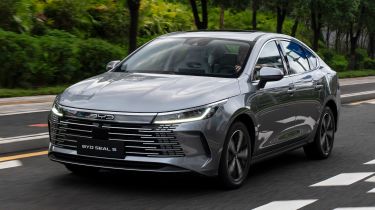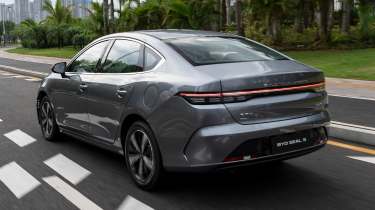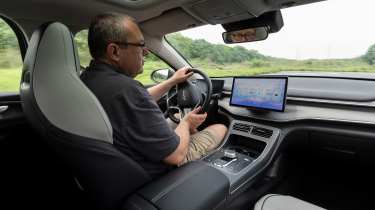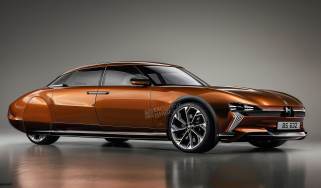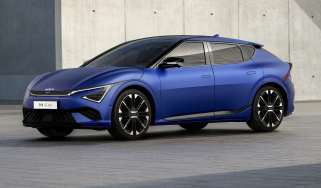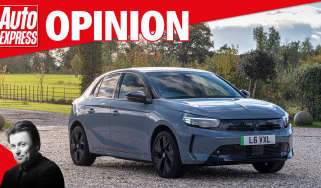New BYD Seal 5 DM-i 2024 review: plug-in hybrid saloon is understated but also underwhelming
The plug-in hybrid BYD Seal 5 DM-i could come to the UK next year, but first impressions are a bit of a mixed bag
Verdict
Saloons are already something of a niche in the UK market, so BYD’s plug-in hybrid take on the genre is going to appeal to a limited number of buyers here. Assuming it would be shod with better tyres for British customers, it seems a solid, if unspectacular performer – and that’s likely to mean that its biggest draw could be that chunky battery and real-world EV range of well over 40 miles. It’s unlikely to be a mainstream hit – but it has the potential to find favour with some company-car choosers and those after a cheap car for professional use.
BYD has big plans for Europe, including the UK – and that means we’re going to see a plethora of new models from the Chinese giant over the next couple of years. There’s an emphasis on electric cars, of course, but BYD also knows that many customers here aren’t ready to ditch petrol just yet. And that's where cars like the Seal 5 DM-i come in.
Confusingly, the Seal 5 is a saloon measuring just over 4.8 metres in length, so slightly longer than the EV that shares most of its name. In terms of technology, it’s a step apart from the all-electric Tesla Model 3 rival, too. So much so we’re not at all convinced it’ll be called Seal 5 at all when it lands in the UK, probably in 2025.
More reviews
In-depth reviews
It’s nowhere near as striking as the Seal EV from a design perspective, either, with an inoffensive but conservative aesthetic that wouldn’t have looked out of place on a Toyota, Kia or Hyundai from a few years ago.
Things are clearer, and more encouraging, beneath the bonnet, because at the heart of it all is BYD’s DM-i plug-in powertrain. It mixes a 1.5-litre petrol engine producing 109bhp with a single electric motor that brings 194bhp. It’s all fed through the front wheels via a CVT transmission, and the electric side of things is supported by an 18.3kWh LFP-chemistry battery that can take the Seal 5 just over 60 miles without using a drop of petrol – although this figure has been certified in China’s less strenuous efficiency test. Even so, we’d be disappointed if the Seal 5 doesn’t crack 40 miles of EV range, dropping it neatly into the eight-per cent band for Benefit-in-Kind tax.
That really could prove crucial, in fact, because the Seal 5 does have a company-car feel to it – to the point where it’s hard to see many private customers committing to a relatively expensive Chinese saloon, even one that can do many a commute on a single charge.
Appropriately, then, the cabin is businesslike rather than lavish; slide into the vegan-leather driver’s seat and you’re presented with a familiar level of tech, including a 12.8-inch infotainment screen that can, as in BYD’s EVs, rotate between landscape and portrait layouts. The gear selector is a simple rotary dial that sits atop a sea of grey at the base of the centre console.
But while the rest of the dashboard is neatly designed and nicely built, there are more hard materials on display than we’ve experienced in any BYD so far, including the sub-£30k Dolphin EV. It’s neat and functional, but doesn’t come close to the premium feel of a Volkswagen Passat, let alone a BMW 330e. We shouldn’t be too surprised by this because elsewhere in the world, the Seal 5 has been pitched as a cheaper alternative to BYD’s Han saloon.
Our brief drive around a soaking race circuit in China proved once again that the country’s local tyre suppliers are some way behind the established brands for wet-weather performance; it was far too easy to pitch the Seal 5 into swathes of understeer in tighter corners. The body feels reasonably well tied down, mind, so we’d hope that more appropriate rubber would be enough for the car to deliver competent, if slightly dull dynamics. Equally, it was hard to judge ride quality on a smooth track, but the Seal 5 didn’t feel like it was bucking its way over the rougher surfaces that we did find.
There are more positive elements to report. As we noted in the Seal U SUV that’s on its way to the UK imminently, the DM-i powertrain delivers a polite experience; put the Seal 5 into HEV mode, to allow the system to choose when it needs the petrol to cut in, and those moments of activation and deactivation occur with the minimum of fuss. You’ll hear the engine, but it’s not particularly harsh, and there’s remarkably little judder or vibration as it fires up – assuming, that is, you can get it to do so, because the system wants (perhaps understandably) to make best use of that chunky battery before resorting to combustion.
We’d want a wider gamut of driving scenarios to form a conclusive view, frankly, but the early signs are that BYD has nailed down a smooth hybrid system. There’s no involvement to be had, but then, this is hardly the focus here.
By now, you’ve probably worked out that one potentially key source of custom for the Seal 5 could be the private hire market – and it definitely seems well set for that use case. There’s plenty of space for four adults on board, with decent headroom in the rear seats for those up to (and slightly beyond) six feet tall. The boot capacity is 450 litres, which isn’t going to trouble VW’s forthcoming estate-only Passat PHEV, but is big enough for a couple of big suitcases.
| Model: | BYD Seal 5 |
| Price: | £38,000 (est) |
| Powertrain: | 1.5-litre 4cyl petrol PHEV, 1x e-motor |
| Transmission: | CVT automatic, front-wheel drive |
| Power/torque: | TBC/TBC |
| 0-62mph: | 7.3 seconds |
| Top speed: | 115mph |
| Economy | TBC |
| Emissions: | TBC |
| EV range: | 63 miles (Chinese test) |
| Size (W/L/H): | 4,780/1,837/1,495mm |
| On sale: | 2025 (TBC) |

